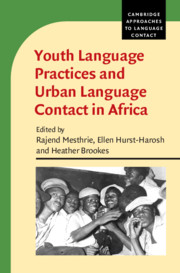Book contents
- Youth Language Practices and Urban Language Contact in Africa
- Cambridge Approaches to Language Contact
- Youth Language Practices and Urban Language Contact in Africa
- Copyright page
- Contents
- Figures
- Tables
- Contributors
- Series Editor’s Foreword
- Preface
- Abbreviations
- Introduction
- 1 Language Contact and Structure in Urban IsiXhosa and Associated Youth Languages
- 2 Not ‘Deep’ but Still IsiXhosa:
- 3 Rethinking Youth Language Practices in South Africa:
- 4 Tsotsitaals, Urban Vernaculars and Contact Linguistics
- 5 Grammatical Hybridity in Camfranglais?
- 6 Sheng and Engsh in Kenya’s Public Spaces and Media
- 7 Exploring Hybridity in Ivorian French and Nouchi
- 8 Authenticity and the Object of Analysis:
- Index
- References
3 - Rethinking Youth Language Practices in South Africa:
An Interactional Sociocultural Perspective
Published online by Cambridge University Press: 20 August 2021
- Youth Language Practices and Urban Language Contact in Africa
- Cambridge Approaches to Language Contact
- Youth Language Practices and Urban Language Contact in Africa
- Copyright page
- Contents
- Figures
- Tables
- Contributors
- Series Editor’s Foreword
- Preface
- Abbreviations
- Introduction
- 1 Language Contact and Structure in Urban IsiXhosa and Associated Youth Languages
- 2 Not ‘Deep’ but Still IsiXhosa:
- 3 Rethinking Youth Language Practices in South Africa:
- 4 Tsotsitaals, Urban Vernaculars and Contact Linguistics
- 5 Grammatical Hybridity in Camfranglais?
- 6 Sheng and Engsh in Kenya’s Public Spaces and Media
- 7 Exploring Hybridity in Ivorian French and Nouchi
- 8 Authenticity and the Object of Analysis:
- Index
- References
Summary
This chapter argues for an alternative view of 'African youth languages' based on ethnographic and ecological approaches that link structural and discursive analyses of spontaneous communicative interactions with immediate situational and local social dynamics and then the broader sociocultural context of the speech community in which these practices occur. Using video recordings of naturally occurring conversations from twenty-two years of observation among male youth in a township in Johannesburg, South Africa, I demonstrate that so-called Tsotsitaal or tsotsitaals are interactive performative practices that constitute a performative register made up of a set of discursive strategies that draw on different linguistic resources in the quest for originality as part of male sociality during a particular life stage. I show that variation in choice of words and other semiotic features of this practice are best explained from a persona-constructionist perspective as part of male sociality where linguistic choices index attitudes, stances and identities in the service of social distinction. Innovations spread based on linguistic skill and status within male social networks. Multivalency accounts for the presence of some of the male youth lexicon in urban vernaculars. Implications for current approaches to the study of youth language in Africa are discussed.
Keywords
- Type
- Chapter
- Information
- Publisher: Cambridge University PressPrint publication year: 2021

